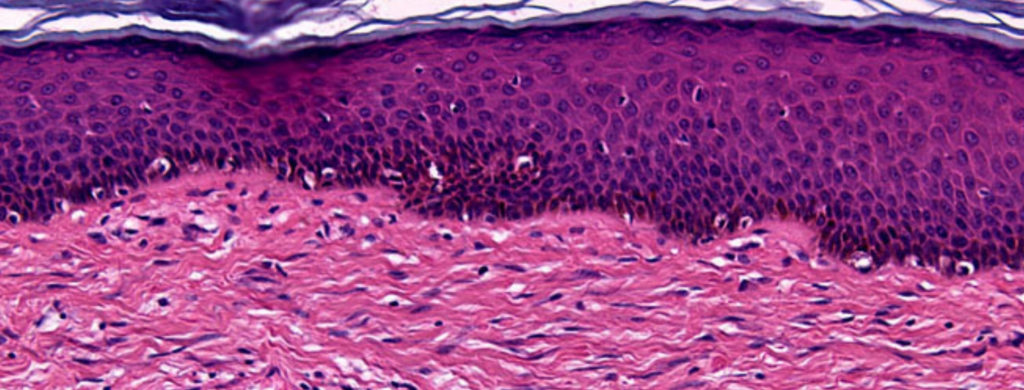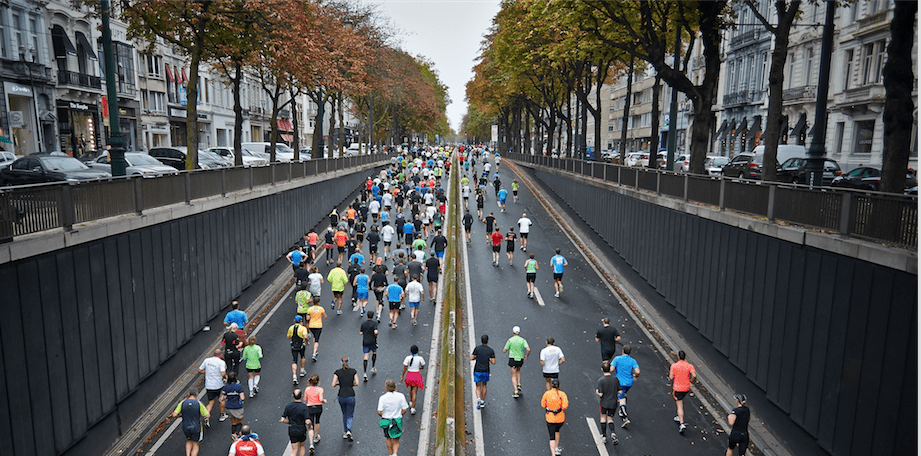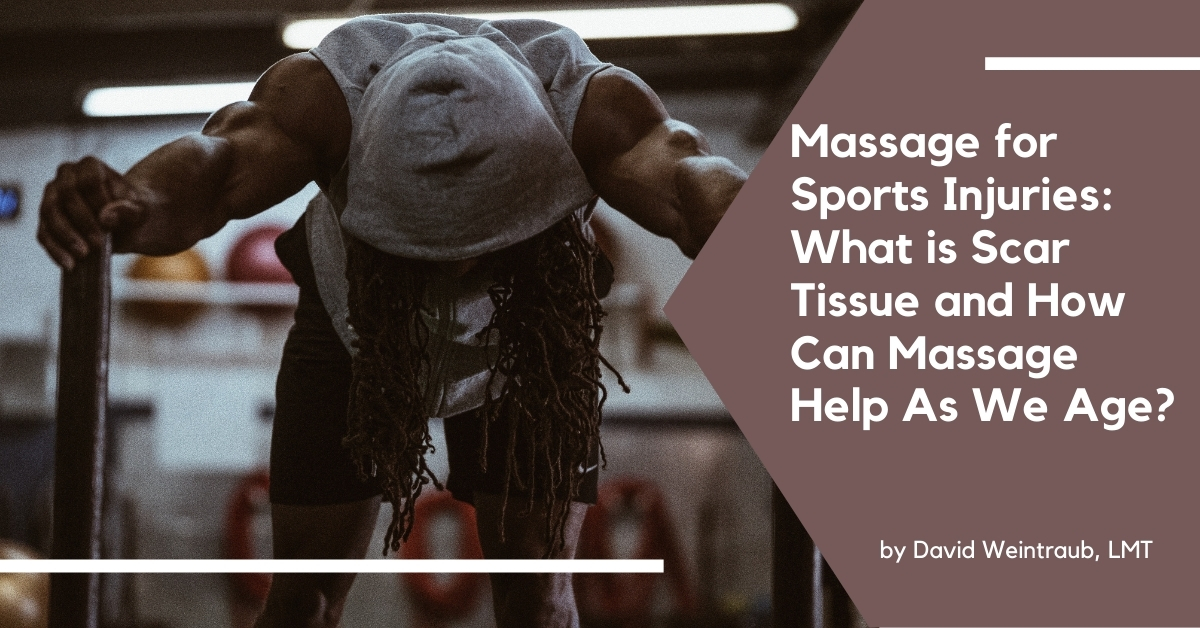Massage for Sports Injuries: What is Scar Tissue and How Can Massage Help As We Age?
David Weintraub, LMT and owner of Bodyworks DW, writes about massage for sport injuries, how to heal from them, and how to prevent them as we age.
When were your first sports injuries?
If you are into sports now, odds are you started playing team sports when you were young. I remember my first soccer tryout at 9. I also remember my first sprained ankle from getting slide tackled at 11. There were a lot more sports injuries where that came from between then and now. Soccer, track, cross country, cycling, swimming, and later aikido. And that one ill fated parkour class during which I sprained my ankle. I wish I had known about massage therapy for sports injuries a lot earlier!
Along the way I’ve sprained both ankles more than once. And severely torn a hamstring muscle twice. I've smashed fingers and toes, and torn a rotator cuff. I've gotten a bone spur on my wrist, had shin splints, plantar fasciitis, hip pain, low back pain, and herniated a disc in my neck.
How I've kept active despite these injuries
To keep moving I've had a lot of bodywork, acupuncture, physical therapy, and chiropractic work since my mid 20’s. Without it, I’d be taped together with duct tape just to function. And probably would have needed a few different surgeries (currently surgery free at 48).
Like most of you, I’ve got the scars to prove my sports history. Unfortunately, as I get older, all of these old sports injuries make it even more likely that I’ll re-injure myself. So I’ve learned the hard way to be more cautious and create a regular self-care routine.
Update Sept 2020: After a 4 month shutdown and high period of intense stress due to COVID-19 I'm definitely feeling some of my old injury sites "show up" more than usual. I'm really happy that our studio has been able to reopen and that we are able to practice safely. And to get some much needed massage for my own body 🙂

How to readjust your routine to avoid pain
Anatomy 101: How scar tissue gets formed
Each time we sustain sports injuries (or any other injuries) our body has to make a decision. It has to decide whether it has time to heal itself with properly functioning replacement tissue or with scar tissue. The more severe the injury, the more likely the body will use scar tissue. If it doesn't, it could "bleed out."
Why?
Building replacement tissue takes time. If you are bleeding internally (or externally) time is a big factor. Your body has to make a choice:
- replace the tissue with beautiful “good as new” skin or muscle and risk bleeding out, infection, death….or
- plug the hole with scar tissue and save itself.
We all have scar tissue in our bodies. Those of us with a sports background likely have a lot more of it. Can you list all the injuries you’ve had?!
What makes scar tissue such an issue
Our bodies are basically a bunch of functional pieces glued together. The glue is called “fascia.” Fascia is non-living tissue that our body makes to stick stuff together. It’s made of mostly water and collagen fibers.
Scar tissue is also non-living tissue that sticks stuff together. And it’s also made of mostly water and collagen fibers.
If they are both water and collagen fibers...what’s the difference?!
In healthy fascia, the collagen fibers are woven together in a cohesive way like fabric. It has structural integrity that allows for some movement and stretching in certain directions and also limits movements in others. When healthy, it acts like an ACE bandage already built into your joints, muscles, tendons, and ligaments.
In scar tissue, the collagen fibers are thrown into place like a pile of pick up sticks. The body has to stop the bleeding from an injury quickly. It doesn’t have time to carefully arrange the collagen fibers for structure and healthy movement. If you have any noticeable skin scars you can attest to the difference. Healthy skin moves and stretches, while a scar feels hard and immobile.
Scar tissue can show up in big ways and also in little ways. Push things too hard and you end up with tiny “micro” tears in the muscle tissue. Most of these will be healed with properly functioning muscle but a few may be just too much for the body to handle without plugging it with scar tissue. Over time these micro-tears add up to restricted movement.
You can’t get rid of scar tissue but massage therapy for sports injuires can help make it move again.
The more scar tissue we have the stiffer and more limited our movements become.
And once scar tissue is formed it’s there for life. The idea that you can “break down scar tissue” and that the body gets rid of it is a modern wellness myth. However, a good massage therapist can help to work into the scar tissue and make it more pliable.
With bodywork and regular stretching the scar tissue can form a better alignment and act more like healthy fascia. So you can usually get most of your range of motion back.
Here’s the really important thing:
The older we get, the slower our body gets at healing, the more likely that injuries are going to be plugged with scar tissue instead of healthy tissue.
Check out this Washington Post Wellness article if you want to read more about this: Click here!
What can I do to prevent sports injuries as I get older and how can massage therapy for sport injuries help?
The first bit of advice I can give is that we all need to readjust our definition of “injury.” I ask hundreds of clients every year about their injuries and many will say, “oh I’ve never really gotten injured….” Which is interesting considering that they are coming to me because they are in pain.
We think of sports injuries as broken bones, torn ACL ligaments, sprained ankles that lay us out for weeks, etc. These absolutely are sports injuries, and major ones. It’s the minor ones we gloss over.
How microtears build up into major injuries
Pushed too hard at the gym yesterday and are feeling a little pinchy “tug” in you hip when you walk up the stairs? That’s an injury; it needs time to heal. But hey, you’ve got to keep to your exercise schedule or you’ll (insert self judgement here). So you go right back to the gym and do another hard workout.
At the beginning the hip is screaming at you, but it “warms up” during the workout and actually feels a bit better now.
The next day it’s yelling at you even more….. And wouldn’t you know it, but your shoulder feels a bit “off.” Yet most of us go back to the gym again anyway.
When you use your emergency systems just to get through everyday life, what’s left for an emergency?
Your body has some amazing tools to be able to function while injured. These include a handy couple of internal drugs called adrenaline (you know and love this one) and cortisol (it numbs pain).
These tools were designed by evolution to make sure that you could keep running or fighting the bear that was chasing you even if it had already injured you. They gave our species a fighting chance and likely saved your ancestors from a bad scrap or two.
Unfortunately, most of us are overusing and addicted to these life saving internal drugs. We mostly use them to bolster our ego and to avoid dealing with the emotional impact of growing older.
So here’s the unvarnished truth: the older you get, the harder it is for your body to recover, the more likely it is that you’ll injure yourself, the more important self care and good maintenance becomes. You can still go hard. However, you'll need a bit more effort on recovery and maintenance.
We aren’t going to “bounce back” like we used to. We can either accept this or break ourselves against the wall of reality. Your choice 🙂

New Rules for Preventing Sports Injuries as we age:
When you Feel Pain, Just Stop
-
If you experience any sharp pain beyond regular soreness and muscle fatigue during exercise, STOP. No really, just stop.
- Do some cool down walking, then light stretching and/or foam rolling (as long as it doesn’t activate the sharp pain area).
- Then hit the showers and call it a day.
- Give your body at least 24 hours to heal itself, then try some light exercise again.
- If you can exercise pain free, great! If not, stop and give your body another 24 hours.
-
Don’t do any exercise that involves those specific muscles while you are experiencing pain.
- All you are going to do is rip up even more tissue in the area.
- However, if it’s your hip that hurts you could do shoulder presses if it doesn’t activate your hip pain.
-
Practice good post workout self care.
- This means a minimum of 10-15 minutes of cool down (walk around until your heart rate decreases) and stretching.
- This is super important as the fascia get heated and more fluid during exercise.
- But the muscles get shorter due to repeated contraction.
- If you don’t stretch out after you work out, your fascia cools down and hardens around the contracted muscles making everything tighter.
-
Get regular massage therapy for sports injuries. If you are looking for sports massage in NYC, come see us, this is one of our specialities 🙂
Additional Helpful Tips:
-
The newest science advocates that for cardiovascular health, do 3-4 HIT (high intensity training) workouts of 30 minutes each with at least 48 hours in between.
- They are just as effective as 1-2 hour long runs 6 days a week.
- Bonus: less time needed, and more recovery time for healing!
-
Variety is healthiest
- which is why you are starting to hear about major football and basketball athletes doing pilates, yoga, ballet, etc.
- Create a mix of different activities that you like.
- Or if you are a dedicated runner or cyclist, mix up the speed or distance of your exercise with short sprints, hill workouts, etc.
-
A hot shower or bath after a workout is a great idea!
- For bonus points, try contrast bathing and douse yourself with cold water for 30 seconds at the end
- In the shower you can try going back and forth between 2 minutes hot, 30 seconds cold a few times
- The heat opens up the blood vessels allowing more blood to wash the fatigued muscles out
- The cold squishes the vessels tighter, squeezing out lactic acids
- Going back and forth acts like a pumping system for your muscles and speeds recovery
-
If sharp pain persists beyond a few days get thee to either a sports massage therapist who’s experienced with injury recovery work and related massage techniques.
- A great practitioner should be able to get you back to the gym (or class or road, etc.) after a session or two.
- The longer you wait to have it checked out, the more likely it will need multiple sessions to relieve it.
- And the more likely that you’ll have injured yourself to the point where you need to take weeks to months off from training to fully recover.
- And nobody wants that!
If you start following the above and incorporating more self-care into your exercise routine, you’ll feel better overall. And be far less likely to experience pain. You’ll also find that a less is more approach will save you time while still meeting all of your exercise goals. Good luck!
Here at Bodyworks DW Advanced Massage Therapy, all of our therapists are highly trained to handle sports injuries in their many varieties. We’ll be able to look at your form and see if an older injury is throwing your alignment off and really find the source of the current pain so that you can get back to it quickly, with more knowledge of how to prevent a relapse. We’ll also be able to assess when you have a more serious injury that may require seeing a physical therapist or orthopedic doctor. Book at sports massage in midtown or fidi!
Book Appointment


Pingback: Massage for Sports Injuries: What is Scar Tissue and How Can Massage Help As We Age? – Bodyworks DW